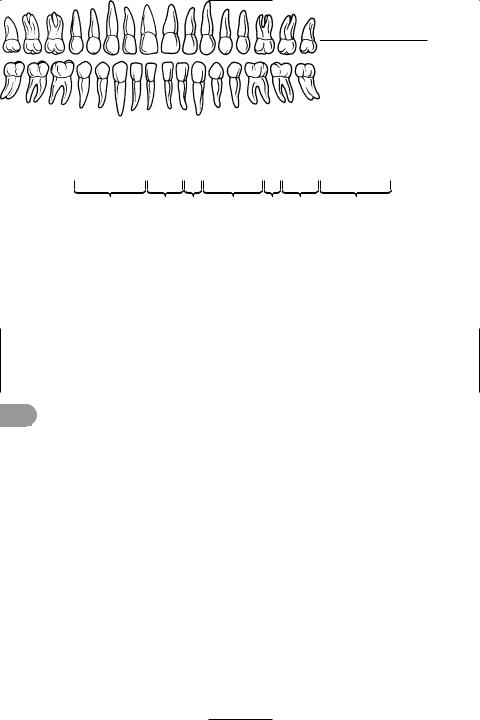
A Dictionary of Science
.pdf
pentose |
606 |
upper |
humerus |
arm |
|
|
radius |
forearm |
|
|
ulna |
wrist |
carpals (actual number |
in man is reduced to 8) |
|
palm |
metacarpals |
|
phalanges |
fingers |
|
A basic pentadactyl forelimb, as exemplified by the human arm
|
|
humerus |
humerus |
humerus |
|
|
carpals ulna |
|
|
metacarpals |
|
ulna |
radius |
|
|
|
|
||
|
radius |
ulna |
radius |
|
carpals |
|
|
p
metacarpals
phalanges
phalanges
cloven hoof
flipper of whale |
foreleg of pig |
wing of bat |
The modified pentadactyl forelimb of various vertebrates
anode as a result of secondary emission. The suppressor grid is maintained at a negative potential relative to the anode and to the screen grid.
pentose A sugar that has Üve carbon atoms per molecule. See monosaccharide.
pentose phosphate pathway (pentose shunt) A series of biochemical reactions that results in the conversion of glucose 6-phosphate to ribose 5-phosphate and generates NADPH, which provides reducing power for other metabolic reactions, such as synthesis of fatty acids. Ribose 5-phosphate and its derivatives are components of such molecules as ATP,
coenzyme A, NAD, FAD, DNA, and RNA. In plants the pentose phosphate pathway also plays a role in the synthesis of sugars from carbon dioxide. In animals the pathway occurs at various sites, including the liver and adipose tissue.
pentyl group or radical The organic group CH3CH2CH2CH2CH2–, derived from pentane.
penumbra See shadow.
pepo See berry.
pepsin An enzyme that catalyses the breakdown of proteins to polypeptides in the vertebrate stomach. It is secreted as an inactive precursor, *pepsinogen.

607 |
pericardial cavity |
pepsinogen The inactive precursor of the enzyme *pepsin. Pepsinogen is secreted by the lining of the vertebrate stomach into the lumen, where it is converted to pepsin by hydrochloric acid and also by the action of pepsin itself.
peptidase See endopeptidase; exopeptidase; protease.
peptide Any of a group of organic compounds comprising two or more amino acids linked by peptide bonds. These bonds are formed by the reaction between adjacent carboxyl (–COOH) and amino (–NH2) groups with the elimination of water (see illustration). Dipeptides contain two amino acids, tripeptides three, and so on. *Polypeptides contain more than ten and usually 100–300. Naturally occurring oligopeptides (of less than ten amino acids) include the tripeptide glutathione and the pituitary hormones antidiuretic hormone and oxytocin, which are octapeptides. Peptides also result from protein breakdown, e.g. during digestion.
per- PreÜx indicating that a chemical compound contains an excess of an element, e.g. a peroxide.
percentile For a random variable in *statistics, any of the 99 values that divide its distribution such that an integral percentage of the collection lies below that value. For example, the 85th percentile is the value of a variable that has 85% of the collection below that value. The 25th percentile is called the lower quartile, the 50th percentile is the median, and the 75th percentile is the upper quartile.
perchlorate See chlorates.
perchloric acid See chloric(vii) acid.
perdisulphuric acid See peroxosulphuric(vi) acid.
perennation The survival of biennial or
perennial plants from one year to the next by vegetative means. In biennials and herbaceous perennials the aerial parts of the plant die down and the plants survive by means of underground storage roots (e.g. carrot), *rhizomes (e.g. couch grass, Solomon’s seal), *tubers (e.g. dahlia), *bulbs (e.g. daffodil, snowdrop), or *corms (e.g. crocus, gladiolus). These perennating organs are also frequently responsible for *vegetative propagation. Woody perennials survive the winter by reducing their metabolic activity (e.g. by leaf loss in deciduous trees and shrubs).
perennial A plant that lives for a number of years. Woody perennials (trees and shrubs) have a permanent aerial form, which continues to grow year after year. Herbaceous (i.e. nonwoody) perennials have aerial shoots that die down each autumn and are replaced in spring by new shoots from an underground structure (see perennation). Lupin and rhubarb are examples of herbaceous perennials. Compare annual; biennial; ephemeral.
perfect gas See ideal gas; gas.
perfect pitch See absolute pitch.
perfect solution See raoult’s law.
perianth The part of a Ûower situated outside the stamens and carpels. In di-
cotyledons it consists of two distinct p whorls, the outer of sepals (see calyx) and
the inner of petals (see corolla). In monocotyledons the two whorls are similar and often brightly coloured. In windpollinated Ûowers both whorls may be reduced or absent. In many horticultural varieties the number of perianth parts is multiplied, but the resulting ‘double’ Ûowers are often sterile.
periastron See apastron.
pericardial cavity The cavity in verte-
|
|
H |
|
R |
|
O |
|
H |
|
R′ O |
|
|
H |
|
R |
|
O H R′ |
O |
|||||||||||||||||||||||||
|
|
|
|
|
|
|
|
|
|
|
|
|
|
|
|
|
|
|
|
|
|
|
|
|
|
|
|
|
|
|
|
|
|
|
|
|
|
|
|
|
|
||
H |
|
N |
|
C |
|
C |
|
OH + H |
|
N |
|
C |
|
C |
|
OH |
H |
|
N |
|
C |
|
C |
|
N |
|
C |
|
C |
|
OH + H2O |
||||||||||||
|
|
|
|
|
|
|
|
|
|
|
|
||||||||||||||||||||||||||||||||
|
|
|
|
|
|
|
|
|
|
|
|
|
|
||||||||||||||||||||||||||||||
|
|
|
|
|
|
|
|
|
|
|
|
||||||||||||||||||||||||||||||||
|
|
|
|
|
|
|
|
|
|
|
|
|
|
|
|
|
|
|
|
|
|
|
|
|
|
|
|
|
|
|
|
|
|
|
|
|
|
|
|
|
|
||
|
|
|
|
|
H |
|
|
|
|
H |
|
|
|
|
|
H |
|
|
|
|
H |
|
|
|
|
||||||||||||||||||
|
amino acid 1 |
amino acid 2 |
|
|
|
|
|
|
|
dipeptide |
|
|
|
water |
|||||||||||||||||||||||||||||
|
|
|
|
peptide bond |
|
|
|
|
|
|
|
|
|
|
|
|
|
|
|
|
|
|
|
|
|
|
|
|
|
|
|
|
|
|
|
|
|||||||
|
|
|
|
|
|
|
|
|
|
|
|
|
|
|
|
|
|
|
|
|
|
|
|
|
|
|
|
|
|
|
|
|
|
|
|
||||||||
Formation of a peptide bond

pericardium |
608 |
brates that contains the heart and is bounded by a membrane (the *pericardium). It is part of the *coelom.
pericardium (pericardial membrane)
The membrane that encloses the pericardial cavity, containing the vertebrate heart. The pericardium holds the heart in position while allowing it to relax and contract. It consists of two main parts: a tough outer Übrous layer (Übrous pericardium) and the more delicate serous pericardium, which consists of a double layer of *serous membrane, the inner layer being in close contact with the heart.
pericarp (fruit wall) The part of a fruit that develops from the ovary wall of a Ûower. The type of fruit that develops depends on whether the pericarp becomes dry and hard or soft and Ûeshy. The pericarp can be made up of three layers. The outer skin (epicarp or exocarp) may be tough and hard; the middle layer (mesocarp) may be succulent as in peach, hard as in almond, or Übrous as in coconut; and the inner layer (endocarp) may be hard and stony as in many *drupes, membranous as in citrus fruits, or indistinguishable from the mesocarp, as in many *berries.
pericycle A plant tissue comprising the
poutermost layer of the root vascular tissue, lying immediately beneath the *endodermis. Lateral roots originate from the pericycle.
pericynthion The point in the orbit around the moon of a satellite launched from the earth that is nearest to the moon. For a satellite launched from the moon the equivalent point is the perilune.
Compare apocynthion. periderm See cork cambium. perigee See apogee.
perihelion The point in the orbit of a planet, comet, or artiÜcial satellite in solar orbit at which it is nearest to the sun. The earth is at perihelion on about 3 January.
Compare aphelion.
perilymph The Ûuid of the *inner ear that Ülls the space between the bony labyrinth and the membranous labyrinth.
Compare endolymph.
period 1. The time taken for one complete cycle of an oscillating system or wave. 2. See periodic table. 3. See menstrual cycle. 4. See geological time scale.
period doubling A mechanism for describing the transition to *chaos in certain dynamical systems. If the force on a body produces a regular orbit with a speciÜc *period a sudden increase in the force can suddenly double the period of the orbit and the motion becomes more complex. The original simple motion is called a one-cycle, while the more complicated motion after the period doubling is called a two-cycle. The process of period doubling can continue until a motion called an n-cycle is produced. As n increases to inÜnity the motion becomes non-periodic. The period-doubling route to chaos occurs in many systems involving nonlinearity, including lasers and certain chaotic chemical reactions. The period-doubling route to chaos was postulated and investigated by the US physicist Mitchell Feigenbaum in the early 1980s. Routes to chaos other than period doubling also exist.
periodic acid See iodic(vii) acid.
periodic law The principle that the physical and chemical properties of elements are a periodic function of their proton number. The concept was Ürst proposed in 1869 by Dimitri Mendeleev, using relative atomic mass rather than proton number, as a culmination of efforts to rationalize chemical properties by Johann Döbereiner (1817), John Newlands (1863), and Lothar Meyer (1864). One of the major successes of the periodic law was its ability to predict chemical and physical properties of undiscovered elements and unknown compounds that were later conÜrmed experimentally. See periodic table.
periodic motion Any motion of a system that is continuously and identically repeated. The time T that it takes to complete one cycle of an oscillation or wave motion is called the *period, which is the reciprocal of the *frequency. See pendulum; simple harmonic motion.
periodic table A table of elements ar-

609 |
Perissodactyla |
ranged in order of increasing proton number to show the similarities of chemical elements with related electronic conÜgurations. (The original form was proposed by Dimitri Mendeleev in 1869 using relative atomic masses.) In the modern short form, the *lanthanoids and *actinoids are not shown. The elements fall into vertical columns, known as groups. Going down a group, the atoms of the elements all have the same outer shell structure, but an increasing number of inner shells. Traditionally, the alkali metals were shown on the left of the table and the groups were numbered IA to VIIA, IB to VIIB, and 0 (for the noble gases). All the elements in the middle of the table are classiÜed as *transition elements and the nontransition elements are regarded as main-group elements. Because of confusion in the past regarding the numbering of groups and the designations of subgroups, modern practice is to number the groups across the table from 1 to 18 (see Appendix). Horizontal rows in the table are periods. The Ürst three are called short periods; the next four (which include transition elements) are long periods. Within a period, the atoms of all the elements have the same number of shells, but with a steadily increasing number of electrons in the outer shell. The periodic table can also be divided into four blocks depending on the type of shell being Ülled: the *s-block, the *p-block, the *d-block, and the *f-block.
There are certain general features of chemical behaviour shown in the periodic table. In moving down a group, there is an increase in metallic character because of the increased size of the atom. In going across a period, there is a change from metallic (electropositive) behaviour to nonmetallic (electronegative) because of the increasing number of electrons in the outer shell. Consequently, metallic elements tend to be those on the left and towards the bottom of the table; nonmetallic elements are towards the top and the right.
There is also a signiÜcant difference between the elements of the second short period (lithium to Ûuorine) and the other elements in their respective groups. This is because the atoms in the second period are smaller and their valence electrons are shielded by a small 1s2 inner shell.
Atoms in the other periods have inner s- and p-electrons shielding the outer electrons from the nucleus. Moreover, those in the second period only have s- and p- orbitals available for bonding. Heavier atoms can also promote electrons to vacant d-orbitals in their outer shell and use these for bonding. See also diagonal relationship; inert-pair effect.
periodontal membrane The membrane of connective tissue that surrounds the root of a *tooth and anchors it to its socket in the jawbone. Fibres of the periodontal membrane pass into the *cement covering the root, which provides a Ürm attachment.
periosteum The outer membrane that surrounds a bone. It contains connective tissue, capillaries, nerves, and a number of types of bone cell. The periosteum plays an important role in bone repair and growth.
peripheral device Any device, such as an input or output device, connected to the central processing unit of a *computer. Backing store is also usually regarded as a peripheral.
peripheral nervous system All parts of the nervous system excluding the *central nervous system. It consists of all the
*cranial and *spinal nerves and their p branches, which link the *receptors and *effectors with the central nervous sys-
tem. See also autonomic nervous system.
periscope An optical device that enables an observer to see over or around opaque objects. The simplest type consists of a long tube with mirrors at each end set at 45° to the direction to be viewed. A better type uses internally reÛecting prisms instead of plane mirrors. Periscopes are used in tanks (to enable the observer to see over obstacles without being shot at) and in submarines (when the vessel is submerged). Such periscopes are usually quite complicated instruments and include telescopes.
Perissodactyla An order of mammals having hoofed feet with an odd number of toes. They are all herbivores and include the tapirs, rhinoceros, and horse. The teeth are large and specialized for grinding. Cellulose digestion occurs in the

peristalsis |
610 |
upper jaw
right |
left |
side |
side |
molars |
precanines |
incisors canines pre- |
molars |
|
molars |
molars |
|
Permanent teeth of an adult human
caecum and large intestine. Fossils of the Eocene epoch, 60 million years ago, show that these animals were at that time already distinct from the cloven-hoofed *Artiodactyla.
peristalsis Waves of involuntary muscular contraction and relaxation that pass along the alimentary canal, forcing food contents along. It is brought about by contraction of the circular muscles of the gut wall in sequence.
peristome 1. A ring of toothlike structures around the opening of a moss *cap-
psule. The teeth tend to bend and twist in dry weather, so opening the mouth of the capsule and allowing the spores to escape. In wet weather they close over the opening of the capsule. 2. The area around the mouth in many invertebrates. It sometimes assists in food collecting. Examples are the spirally ciliated groove around the
mouth of some ciliate protozoans and the Ürst segment of the earthworm.
peritoneum The thin layer of tissue (see serous membrane) that lines the abdominal cavity of vertebrates and covers the abdominal organs. See also mesentery.
Perkin, Sir William Henry (1838–1907)
British chemist, who while still a student accidentally produced mauvine, the Ürst aniline dye and the Ürst dyestuff to be synthesized. Perkin built a factory to produce it, and made a fortune.
permafrost Permanently frozen soil and subsoil that occurs in arctic, subarc-
tic, and alpine regions. It ranges from 30 cm to over 1000 m thick and covers nearly a Üfth of the land surface of the earth. In summer the top few centimetres may thaw, forming pools of meltwater (which cannot drain through the frozen soil beneath).
Permalloys A group of alloys of high magnetic permeability consisting of iron and nickel (usually 40–80%) often with small amounts of other elements (e.g. 3–5% molybdenum, copper, chromium, or tungsten). They are used in thin foils in electronic transformers, for magnetic shielding, and in computer memories.
permanent gas A gas, such as oxygen or nitrogen, that was formerly thought to be impossible to liquefy. A permanent gas is now regarded as one that cannot be liqueÜed by pressure alone at normal temperatures (i.e. a gas that has a critical temperature below room temperature).
permanent hardness See hardness of water.
permanent magnet See magnet.
permanent teeth The second and Ünal set of teeth that mammals produce after shedding the *deciduous teeth. An adult human normally has 32 permanent teeth, consisting of incisors, canines, molars, and premolars (see illustration). These usually appear between the ages of approximately 6 and 21 years. See also dental formula; diphyodont.
permanganate See manganate(vii).

611 |
peroxosulphuric(VI) acid |
permeability (magnetic permeability)
Symbol µ. The ratio of the magnetic Ûux density, B, in a substance to the external Üeld strength, H; i.e. µ = B/H. The permeability of free space, µ0, is also called the magnetic constant and has the value 4π ×
10–7 H m–1 in *SI units. The relative permeability of a substance, µr, is given by µ/µ0 and is therefore dimensionless. See magnetism.
Permian The last geological period in the Palaeozoic era. It extended from the end of the Carboniferous period, about 286 million years ago, to the beginning of the Mesozoic era, about 248 million years ago. It was named by the British geologist Roderick Murchison (1792–1871) in 1841 after the Perm province in Russia. In some areas continental conditions prevailed, which continued into the following period, the Triassic. These conditions resulted in the deposition of the New Red Sandstone. During the period a number of animal groups became extinct, including the trilobites, tabulate and rugose corals, and blastoids (see mass extinction). Amphibians and reptiles continued to be the dominant land animals and gymnosperms replaced ferns, clubmosses, and horsetails as the dominant plants.
permittivity Symbol ε. The ratio of the *electric displacement in a medium to the intensity of the electric Üeld producing it. It is important for electrical insulators used as *dielectrics.
If two charges Q 1 and Q 2 are separated by a distance r in a vacuum, the force F between the charges is given by:
F = Q 1Q 2/r24πε0
In this statement of *Coulomb’s law using *SI units, ε0 is called the absolute permittivity of free space, which is now known as the electric constant. It has the value 8.854 × 10–12 F m–1.
If the medium between the charges is anything other than a vacuum the equation becomes:
F = Q 1Q 2/r24πε
and the force between the charges is reduced. ε is the absolute permittivity of the new medium. The relative permittivity (εr) of a medium, formerly called the dielectric constant, is given by εr = ε/ε0.
permonosulphuric(VI) acid See peroxosulphuric(vi) acid.
permutations and combinations A combination is any subset of a particular set of objects, regardless of the order of selection. If the set consists of n objects, r objects can be selected giving n!/r!(n – r)! different combinations. This can be writ-
ten nCr.
A permutation is an ordered subset (i.e. attention is paid to the order of selection or arrangement) of a particular set of objects. If the set consists of n objects, r such objects can be selected to give n!/(n – r)! permutations. This is written nPr.
Permutit Trade name for a *zeolite used for water softening.
peroxides 1. A group of inorganic compounds that contain the O22– ion. They are notionally derived from hydrogen peroxide, H2O2, but these ions do not exist in aqueous solution due to extremely rapid hydrolysis to OH–. 2. A class of organic compounds that contain the –O–O– group. Organic peroxides tend to be unstable and some are explosive. They can be used to initiate free-radical reactions.
peroxisome An organelle, found in the cytoplasm of virtually all plant and animal cells, that contains several enzymes
involved in oxidation processes. Peroxi- p somes are bound by a single membrane;
the enzymes they contain include urate oxidase and catalase (which catalyses the breakdown of hydrogen peroxide, produced as a by-product of the activity of the other enzymes). Peroxisomes are active in the process of *detoxiÜcation, being particularly abundant in the liver and in the *proximal convoluted tubules of the kidney. In plant cells they are the main site of *fatty-acid oxidation.
peroxodisulphuric acid See peroxosulphuric(vi) acid.
peroxomonosulphuric(VI) acid See peroxosulphuric(vi) acid.
peroxosulphuric(VI) acid The term commonly refers to peroxomonosulphuric(VI) acid, H2SO5, which is also called permonosulphuric(VI) acid and Caro’s acid. It is a crystalline compound made by the action of hydrogen peroxide on concen-

perpetual motion |
612 |
trated sulphuric acid. It decomposes in water and the crystals decompose, with melting, above 45°C. The compound peroxodisulphuric acid, H2S2O8, also exists (formerly called perdisulphuric acid). It is made by the high-current electrolysis of sulphate solutions. It decomposes at 65°C (with melting) and is hydrolysed in water to give the mono acid and sulphuric acid. Both peroxo acids are very powerful oxidizing agents. See also sulphuric acid (for structural formulas).
perpetual motion 1. Perpetual motion of the Ürst kind. Motion in which a mechanism, once started, would continue indeÜnitely to perform useful work without being supplied with energy from an outside source. Such a device would contravene the Ürst law of *thermodynamics and is therefore not feasible. Many historical attempts, exercising great ingenuity, were constructed before the concept of energy and its conservation were understood. Some attempts have been made, since the Ürst law of thermodynamics became generally accepted, by inventors seeking to establish loopholes in the laws of nature. 2. Perpetual motion of the second kind. Motion in which a mechanism extracts heat from a source and converts all of it into some other form of energy.
pAn example of such a mechanism would be a ship that utilized the internal energy
of the oceans for propulsion. Such a device does not contravene the Ürst law of thermodynamics but it does contravene the second law. In the case of the ship, the sea would have to be at a higher tem-
perature than the ship to establish a useful Ûow of heat. This could not occur without an external energy source.
3. Perpetual motion of the third kind. A form of motion that continues indeÜnitely but without doing any useful work. An example is the random molecular motion in a substance. This type postulates the complete elimination of friction. A mechanism consisting of frictionless bearings
maintained in a vacuum could turn indeÜnitely, once started, without contravening the Ürst or second laws of thermodynamics, provided it did no external work. Experience indicates that on the macroscopic scale such a condition cannot be achieved. On the microscopic scale,
however, a superconducting ring of wire will apparently sustain a perpetual current Ûow without the application of an external force. This could be considered a form of perpetual motion of the third kind, if the energy required to cool the wire to superconducting temperatures is ignored.
personal computer A general-purpose
*microcomputer designed for use by one person at a time. The original Personal Computer (or PC) was a highly successful product from IBM. An IBM-compatible computer is functionally identical to an IBM PC and able to accept all hardware and software intended for it. The abbreviation PC is now most often used to mean an IBM-compatible computer as opposed to other systems. Personal computers range widely in capability and cost. They may take the form of desktop computers or be portable versions, such as laptop, notebook, or subnotebook computers.
Perspex Trade name for a form of *polymethylmethacrylate.
perturbation A departure by a celestial body from the trajectory or orbit it would follow if it moved only under the inÛuence of a single central force. According to *Kepler’s law, for example, a single planet orbiting the sun would move in an elliptical orbit. In fact, planets are perturbed from elliptical orbits by the gravitational forces exerted on them by other planets. Similarly, the moon’s orbit round the earth is perturbed by the gravitational effect of the sun and the trajectories of comets are perturbed when they pass close to planets.
perturbation theory A method used in calculations in both classical physics (e.g. planetary orbits) and quantum mechanics (e.g. atomic structure), in which the system is divided into a part that is exactly calculable and a small term, which prevents the whole system from being exactly calculable. The technique of perturbation theory enables the effects of the small term to be calculated by an inÜnite series (which in general is an asymptotic series). Each term in the series is a ‘correction term’ to the solutions of the exactly calculable system. In classical physics, perturbation theory can be used for calculat-

613 |
petroleum |
ing planetary orbits. In quantum mechanics, it can be used to calculate the energy levels in molecules. In the many-body problem in quantum mechanics and in relativistic quantum Üeld theory, the terms in perturbation theory may be represented pictorially by Feynman diagrams (see quantum electrodynamics).
perversion See lateral inversion.
wind-pollinated plants are usually reduced or absent. Petals are considered to be modiÜed leaves but their structure is simpler. Epidermal hairs may be present and the cuticle is often covered by lines or dots known as honey guides, which direct insects to the *nectar.
Peters’ projection See map projections.
pest Any of various organisms, such as fungi, insects, rodents, and plants, that harm crops or livestock or otherwise interfere with the wellbeing of human beings. Weeds are plant pests that grow where they are not wanted – often on cultivated land, where they compete with crop plants for space, light, nutrients, etc. Pests are controlled by the use of *pesticides and *biological control methods.
pesticide Any chemical compound used to kill pests that destroy agricultural production or are in some way harmful to humans. Pesticides include herbicides (such as *2,4-D and Paraquat), which kill unwanted plants or weeds; insecticides (such as *pyrethrum), which kill insect pests; fungicides, which kill fungi; and rodenticides (such as *warfarin), which kill rodents. The problems associated with pesticides are that they are very often nonspeciÜc and may therefore be toxic to organisms that are not pests; they may also be nonbiodegradable, so that they persist in the environment and may accumulate in living organisms (see bioaccumulation). Organophosphorus insecticides, such as malathion and parathion, are biodegradable but can also damage the respiratory and nervous systems in humans as well as killing useful insects, such as bees. They act as *anticholinesterases. Organochlorine insecticides, such as dieldrin, aldrin, and *DDT, are very persistent and not easily biodegradable.
peta- Symbol P. A preÜx used in the metric system to denote one thousand million million times. For example, 1015 metres = 1 petametre (Pm).
petal One of the parts of the Ûower that make up the *corolla. Petals of insectpollinated plants are usually brightly coloured and often scented. Those of
petiole The stalk that attaches a *leaf blade to the stem. Leaves without petioles are described as sessile.
Petri dish A shallow circular Ûatbottomed dish made of glass or plastic and having a Ütting lid. It is used in laboratories chieÛy for culturing bacteria and other microorganisms. It was invented by the German bacteriologist Julius Petri (1852–1921).
petriÜcation See fossil.
petrochemicals Organic chemicals obtained from petroleum or natural gas.
petroleum A naturally occurring oil that consists chieÛy of hydrocarbons with some other elements, such as sulphur, oxygen, and nitrogen. In its unreÜned form petroleum is known as crude oil
(sometimes rock oil). Petroleum is believed |
|
|
to have been formed from the remains of |
|
|
living organisms that were deposited, to- |
|
|
p |
|
|
gether with rock particles and biochemi- |
|
|
cal and chemical precipitates, in shallow |
|
|
depressions, chieÛy in marine conditions. |
|
|
Under burial and compaction the organic |
|
|
matter went through a series of processes |
|
|
before being transformed into petroleum, |
|
|
which migrated from the source rock to |
|
|
become trapped in large underground |
|
|
reservoirs beneath a layer of impermeable |
|
|
rock. The petroleum often Ûoats above a |
|
|
layer of water and is held under pressure |
|
|
beneath a layer of *natural gas. |
|
|
Petroleum reservoirs are discovered |
|
|
through geological exploration: commer- |
|
|
cially important oil reserves are detected |
|
|
by exploratory narrow-bore drilling. The |
|
|
major known reserves of petroleum are in |
|
|
Saudi Arabia, Russia, China, Kuwait, Iran, |
|
|
Iraq, Mexico, USA, United Arab Emirates, |
|
|
Libya, Venezuela, and beneath the North |
|
|
Sea. The oil is actually obtained by the |
|
|
sinking of an oil well. Before it can be |
|
|
used it is separated by fractional distilla- |
|
|

petroleum ether |
614 |
tion in oil reÜneries. The main fractions obtained are:
(1)ReÜnery gas A mixture of methane, ethane, butane, and propane used as a fuel and for making other organic chemicals.
(2)Gasoline A mixture of hydrocarbons
containing 5 to 8 carbon atoms, boiling in the range 40–180°C. It is used for motor fuels and for making other chemicals.
(3)Kerosine (or paraffin oil) A mixture of
hydrocarbons having 11 or 12 carbon atoms, boiling in the range 160–250°C.
Kerosine is a fuel for jet aircraft and for oil-Üred domestic heating. It is also cracked to produce smaller hydrocarbons for use in motor fuels.
(4)Diesel oil (or gas oil) A mixture of
hydrocarbons having 13 to 25 carbon atoms, boiling in the range 220–350°C. It is a fuel for diesel engines.
The residue is a mixture of higher hydrocarbons. The liquid components are obtained by vacuum distillation and used
in lubricating oils. The solid components (parafÜn wax) are obtained by solvent extraction. The Ünal residue is a black tar containing free carbon (asphalt or bitumen).
petroleum ether A colourless volatile Ûammable mixture of hydrocarbons (not
pan ether), mainly pentane and hexane. It boils in the range 30–70°C and is used as a solvent.
pewter An alloy of lead and tin. It usually contains 63% tin; pewter tankards and food containers should have less than 35% of lead so that the lead remains in solid solution with the tin in the presence of weak acids in the food and drink. Copper is sometimes added to increase ductility and antimony is added if a hard alloy is required.
Pfund series See hydrogen spectrum.
PGD See preimplantation genetic diagnosis.
pH See ph scale.
PHA See phytohaemagglutinin.
Phaeophyta (brown algae) A phylum of
*algae in which the green chlorophyll pigments are usually masked by the brown pigment fucoxanthin. Brown algae are
usually marine (being abundant in cold water) and many species, such as the wracks (Fucus), inhabit intertidal zones. They vary in size from small branched Ülaments to ribbon-like bodies (known as kelps) many metres long.
phage See bacteriophage.
phagocyte A cell that is able to engulf and break down foreign particles, cell debris, and disease-producing microorganisms (see phagocytosis). Many protozoans and certain mammalian cells (e.g. *macrophages and *monocytes) are phagocytes. Phagocytes are important elements in the natural defence mechanism of most animals.
phagocytosis The process by which foreign particles invading the body or minute food particles are engulfed and broken down by certain animal cells (known as *phagocytes). The plasma membrane of the phagocyte invaginates to capture the particle and then closes around it to form a sac or *vacuole. The vacuole coalesces with a *lysosome, which contains enzymes that break down the particle. See endocytosis. Compare pinocytosis.
phalanges The bones that make up the *digits of the hand or foot in vertebrates. They articulate with the *metacarpals of the hand or with the *metatarsals of the foot. In the basic *pentadactyl limb there are two phalanges for the Ürst digit (the thumb or big toe in humans) and three for each of the others.
Phanerozoic The most recent eon of geological time, represented by rock strata containing clearly recognizable fossils. It comprises the *Palaeozoic, *Mesozoic, and *Cenozoic eras and has extended for about 570 million years from the beginning of the Cambrian period.
Compare proterozoic.
pharmacogenomics (pharmacogenetics) The study of how genes affect the actions of drugs. The enormous growth in knowledge about human genetics arising from the *Human Genome Project, coupled with the rapid advance of computer systems to analyse the vast amounts of data, has revolutionized drug discovery and development. This approach, which

615 |
phase I metabolism |
combines *genomics and pharmacology, improves understanding of drug actions, suggests new potential drug molecules, and enables computer-based searches for likely drug targets. It also raises the prospect of drugs being tailor-made to suit the genetic make-up of particular patients or groups of patients. This more precise targeting of drugs should make drugs more effective, with less risk of adverse side effects.
pharmacokinetics The movement of foreign substances, particularly drugs, throughout the body of an animal. Processes that inÛuence the pharmacokinetics of a compound include uptake, distribution throughout the body tissues, the length of time the compound remains in the body, and its rate of clearance (e.g. by metabolism or excretion).
pharmacology The study of the properties of drugs and their effects on living organisms. Clinical pharmacology is concerned with the effects of drugs in treating disease.
pharynx 1. The cavity in vertebrates between the mouth and the *oesophagus and windpipe (*trachea), which serves for the passage of both food and respiratory gases. The presence of food in the pharynx stimulates swallowing (see deglutition). In Üsh and aquatic amphibians the pharynx is perforated by *gill slits. 2. The corresponding region in invertebrates.
phase 1. A homogeneous part of a heterogeneous system that is separated from other parts by a distinguishable boundary. A mixture of ice and water is a two-phase system. A solution of salt in water is a single-phase system. 2. A description of the stage that a periodic motion has reached, usually by comparison with another such motion of the same frequency. Two varying quantities are said to be in phase if their maximum and minimum values occur at the same instants; otherwise, there is said to be a phase difference. See also phase angle. 3. One of the circuits in an electrical system or device in which there are two or more alternating currents that are not in phase with each other. In a three-phase system the displacement between the currents is one
third of a period. 4. See phases of the moon.
phase angle The difference in *phase between two sinusoidally varying quantities. The displacement x1 of one quantity at time t is given by x1 = asinωt, where ω is the angular frequency and a is the amplitude. The displacement x2 of a similar wave that reaches the end of its period T, a fraction β of the period before the Ürst is said to lead the Ürst quantity by a time βT; if it reaches the end of its period, a fraction β of the period after the Ürst quantity it lags by a time βT. The value of x2 is then given by x2 = asin(ωt + φ). φ is called the phase angle and it is equal to 2πβ.
phase-contrast microscope A type of
*microscope that is widely used for examining such specimens as biological cells and tissues. It makes visible the changes in phase that occur when nonuniformly transparent specimens are illuminated. In passing through an object the light is slowed down and becomes out of phase with the original light. With transparent specimens having some structure *diffraction occurs, causing a larger phase change in light outside the central maximum of the pattern. The phase-contrast microscope provides a means of combining this light with that of the central maximum
by means of an annular diaphragm and a p phase-contrast plate, which produces a
matching phase change in the light of the central maximum only. This gives greater contrast to the Ünal image, due to constructive interference between the two sets of light waves. This is bright contrast; in dark contrast a different phase-contrast plate is used to make the same structure appear dark, by destructive interference of the same waves.
phase diagram A graph showing the relationship between solid, liquid, and gaseous *phases over a range of conditions (e.g. temperature and pressure). See steel.
phase I metabolism The Ürst stage in the conversion of a foreign compound, such as a drug or toxin, into a form that can be eliminated by the body. Common reactions during this phase are oxidation, reduction, and hydrolysis; the resulting metabolites are chemically more reactive
